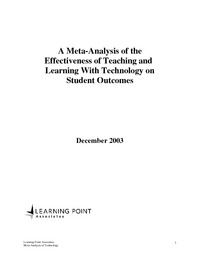A Meta-Analysis of the Effectiveness of Teaching and Learning With Technology on Student Outcomes Meng-Fen Lin, Georgette M. Michko, Hersh C. Waxman Meng-Fen Lin, Georgette M. Michko, Hersh C. Waxman Publikationsdatum:
|
 |
 Diese Seite wurde seit 5 Jahren inhaltlich nicht mehr aktualisiert.
Unter Umständen ist sie nicht mehr aktuell.
Diese Seite wurde seit 5 Jahren inhaltlich nicht mehr aktualisiert.
Unter Umständen ist sie nicht mehr aktuell.
 Zusammenfassungen
Zusammenfassungen
The results of this meta-analysis are generally encouraging. The result from the present study indicate that the overall effects are nearly twice as large as other recent meta-analyses conducted in the area of instructional technology. This finding suggests that the overall effects of technology on student outcomes may be greater than previously thought.
Von Meng-Fen Lin, Georgette M. Michko, Hersh C. Waxman  im Text A Meta-Analysis of the Effectiveness of Teaching and Learning With Technology on Student Outcomes (2003)
im Text A Meta-Analysis of the Effectiveness of Teaching and Learning With Technology on Student Outcomes (2003) The purpose of the present study is to synthesize recent research on the effects of teaching and learning with technology on student outcomes. This quantitative synthesis investigates these results by addressing the following questions:
Von Meng-Fen Lin, Georgette M. Michko, Hersh C. Waxman - How extensive is the empirical evidence on the relationship between teaching and learning with technology and student outcomes?
- What is the magnitude and direction of the relationship between teaching and learning with technology and student outcomes?
- Are there certain social contexts or student characteristics that affect the relationship?
- Are there particular methodological characteristics that affect the relationship?
- Are there specific characteristics of the technology that affect its relationship with student outcomes?
- Are there specific characteristics of instructional features that affect technology’s relationship with student outcomes?
 im Text A Meta-Analysis of the Effectiveness of Teaching and Learning With Technology on Student Outcomes (2003)
im Text A Meta-Analysis of the Effectiveness of Teaching and Learning With Technology on Student Outcomes (2003) To estimate the effects of teaching and learning with technology on students’ cognitive, affective, and behavioral outcomes of learning, 282 effect sizes were calculated using statistical data from 42 studies that contained a combined sample of approximately 7,000 students. The mean of the study-weighted effect sizes averaging across all outcomes was .410 (p < .001), with a 95-percent confidence interval (CI) of .175 to .644. This result indicates that teaching and learning with technology has a small, positive, significant (p < .001) effect on student outcomes when compared to traditional instruction. The mean study-weighted effect size for the 29 studies containing cognitive outcomes was .448, and the mean study-weighted effect size for the 10 comparisons that focused on student affective outcomes was .464. On the other hand, the mean study-weighted effect size for the 3 studies that contained behavioral outcomes was -.091, indicating that technology had a small, negative effect on students’ behavioral outcomes. The overall study-weighted effects were constant across the categories of study characteristics, quality of study indicators, technology characteristics, and instructional/teaching characteristics.
Von Meng-Fen Lin, Georgette M. Michko, Hersh C. Waxman  im Text A Meta-Analysis of the Effectiveness of Teaching and Learning With Technology on Student Outcomes (2003)
im Text A Meta-Analysis of the Effectiveness of Teaching and Learning With Technology on Student Outcomes (2003)  Dieser Text erwähnt ...
Dieser Text erwähnt ...
 Personen KB IB clear | Gene V. Glass , Chen-Lin Kulik , James A. Kulik , Barry McGaw , Mary Lee Smith | ||||||||||||||||||
 Fragen KB IB clear | Hilft Multimedia beim Lernen?
Was bringt Computereinsatz in der Schule? | ||||||||||||||||||
 Begriffe KB IB clear | CAIcomputer aided instruction
,  Lernen Lernen learning
, Metaanalysemeta-analysis
, microworldmicroworld learning
, Metaanalysemeta-analysis
, microworldmicroworld
| ||||||||||||||||||
 Bücher |
| ||||||||||||||||||
 Texte |
|
 Dieser Text erwähnt vermutlich nicht ...
Dieser Text erwähnt vermutlich nicht ... 
 Nicht erwähnte Begriffe | Effektstärke |
 Zitationsgraph
Zitationsgraph
 Zitationsgraph (Beta-Test mit vis.js)
Zitationsgraph (Beta-Test mit vis.js)
 Volltext dieses Dokuments
Volltext dieses Dokuments
 |  A Meta-Analysis of the Effectiveness of Teaching and Learning With Technology on Student Outcomes: Artikel als Volltext ( A Meta-Analysis of the Effectiveness of Teaching and Learning With Technology on Student Outcomes: Artikel als Volltext ( : :  , 239 kByte; , 239 kByte;  : :  2021-03-21) 2021-03-21) |
 Anderswo suchen
Anderswo suchen 
 Beat und dieser Text
Beat und dieser Text
Beat war Co-Leiter des ICT-Kompetenzzentrums TOP während er Dieser Text ins Biblionetz aufgenommen hat. Die bisher letzte Bearbeitung erfolgte während seiner Zeit am Institut für Medien und Schule. Beat besitzt kein physisches, aber ein digitales Exemplar. Eine digitale Version ist auf dem Internet verfügbar (s.o.). Aufgrund der wenigen Einträge im Biblionetz scheint er es nicht wirklich gelesen zu haben. Es gibt bisher auch nur wenige Objekte im Biblionetz, die dieses Werk zitieren.







 Biblionetz-History
Biblionetz-History